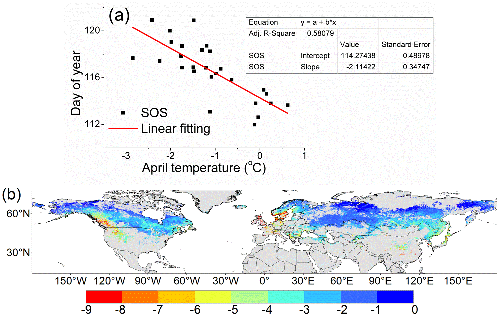Joint investigation revealed the changes in the start of the Vegetation Growing Season during the 21st century
Date:2014-12-08
Global warming due to anthropogenic atmospheric greenhouse effect is known to have advanced the start of the vegetation growing season (SOS) across the globe during the 20th century. Projections of further changes in the SOS for the 21st century under certain emissions scenarios (Representative Concentration Pathways, RCPs) are useful for understanding the consequence of global warming.
Recently, XIA Jiangjiang at the Key Laboratory of Regional Climate-Environment for East Asia, Institute of Atmospheric Physics, and his colleagues from China and the UK made a joint effort to investigate the changes in the SOS during the 21st century. They firstly evaluated the sensitivity of the SOS (defined using the Normalized Difference Vegetation Index - NDVI) to April surface air temperature for land areas of the Northern Hemisphere for period 1982–2008 (Figure 1); then applied this relationship and the ensemble projection of the April temperature under RCPs from the latest state-of-the-art global coupled climate models to calculate changes of SOS in the 21st century.
Their results suggest that for the Northern Hemisphere in average, by the middle of the 21st century (2040–59), the SOS will have advanced by ?4.7 days under RCP2.6, ?8.4 days under RCP4.5, and ?10.1 days under RCP8.5, relative to the present time (1985–2004); by the end of this century (2080–99), it will have advanced by ?4.3 days under RCP2.6, ?11.3 days under RCP4.5, and ?21.6 days under RCP8.5. The geographic pattern of the SOS advances is dependent on that of the temperature sensitivity of the SOS. The larger the temperature sensitivity, the larger the date-shift-rate of the SOS. The regions of large SOS advances include western North America, western Europe, southern Asia, and parts of eastern Canada.

Figure 1. Temperature sensitivity of the SOS, e.g. the regression coefficients of the SOS onto April temperature for 1982–2008, (a) averaged over the analyzed areas and (b) at each grid. Only grids that show a significant linear relationship are marked (significance level: 0.05). Units: d °C?1.
Citation: Xia, J. J., Yan, Z.W., Jia G.S., Zeng H.Q., Jones P.D., Zhou W., Zhang A.Z., 2015: Projections of the Advance in the Start of the Growing Season During the 21st Century Based on CMIP5 Simulations. Advances in Atmospheric Sciences, doi: 10.1007/s00376-014-4125-0
Keywords:
start of growing season (SOS), normalized difference vegetation index (NDVI), temperature sensitivity, Representative Concentration Pathways (RCPs), CMIP5